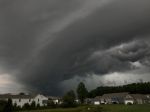Story by Michael Scott
Catching rain is catching on in Northeast Ohio.
Thousands of businesses and homeowners from Cleveland to Parma to Shaker Heights have already hooked up rain barrels to their downspouts.
And a lesser, but growing, number of others are planting water-absorbing rain gardens in their yards — or in some cases, even ripping out old pavement in favor of more modern, porous materials.
The most enthusiastic among them say that an emergent rain-harvesting movement marks a new era of conservation and pollution control on the shores of Lake Erie and the Great Lakes, the world’s largest freshwater system.
Others see a more utilitarian motive — property owners hoping to catch a minor break on a major new storm water fee looming for Cleveland and more than 60 of its suburbs who are part of a regional sewer system.
Still others are a bit wary that a barrage of rain barrels — most in Cleveland are blue, plastic 55-gallon barrels hooked up to a downspout — aren’t exactly going to look like a civic improvement, even if they are saving water and money.
“That’s not going to be a major concern in Cleveland, where most of them will be in the back yard anyway,” said Andrew Watterson, sustainability director for the city of Cleveland. “And rain barrels, rain gardens and other smart ways to reduce storm water are only going to become more popular.
“They do make a difference.”
Storm water woes: floods and pollution
Environmental experts and sewer officials agree, saying that any reduction of rain water flowing into storm sewers in the region is a good thing for neighborhoods and the environment — especially the Cuyahoga River and Lake Erie.
That’s because even moderate rain runoff from roofs, streets and parking lots — when multiplied by the hundreds of square miles of impervious surfaces in developed areas — can quickly develop into major flooding and sanitary-storm sewer overflows.
Initially, the Northeast Ohio Regional Sewer District responded with expensive projects such as the Mill Creek Tunnel, a supersized underground pipe that catches the sewage-storm water mix and holds it until there is capacity at a treatment plant.
Now, district officials want to finance similar projects through a new fee on property owners beginning in October — one based on the square footage of impervious surfaces on their land such as roofs, driveways and sidewalks.
Sewer district leaders expect to raise about $38 million a year toward those types of projects (they estimate a $200 million backlog), but also plan simpler solutions such as natural stream and wetland restoration.
If the fee stands (several Summit and Cuyahoga counties are challenging it in court), the owner of an average-size home would pay about $57 a year. A commercial property owner would pay nearly $2,300 on a parcel with 120,000 square feet of roof, parking lot and driveways.
The district is offering discounts, however, for property owners who reduce their runoff — 25 percent (about $14 a year) to homeowners and 75 percent to businesses who prove they have installed retention ponds, swales, rain gardens and porous pavements. Schools can hit a full 100 percent by doing the same and adding two years of water conservation education.
Stopping storm water at the source
That financial concession for simple solutions signals a change in the way society views storm water, said Kyle Dreyfuss-Wells, a watershed program manager at the sewer district.
“For years, the accepted drainage paradigm was to get water off the property as quickly and efficiently as possible,” she said. “There was good reason for that — to prevent flooding of an individual yard or parking lot.
“But today, with more of the community paved over and the system overwhelmed, it makes sense to begin to teach people to manage their runoff right where they are.”
Environmentalists have long advocated two simple methods for doing that — rain barrels to save water for other uses like watering a garden or washing a car and rain gardens, which use loose soil and native plants to collect and slowly filter the rainwater runoff back into the soil.
The sewer district expects to have its guidelines published sometime this month to inform property owners how to specifically qualify for the discounts.
And while rain barrels grab most of the attention, Dreyfuss-Wells and others favor rain gardens as the better solution.
Story Compliments Of the Plain Dealer
















